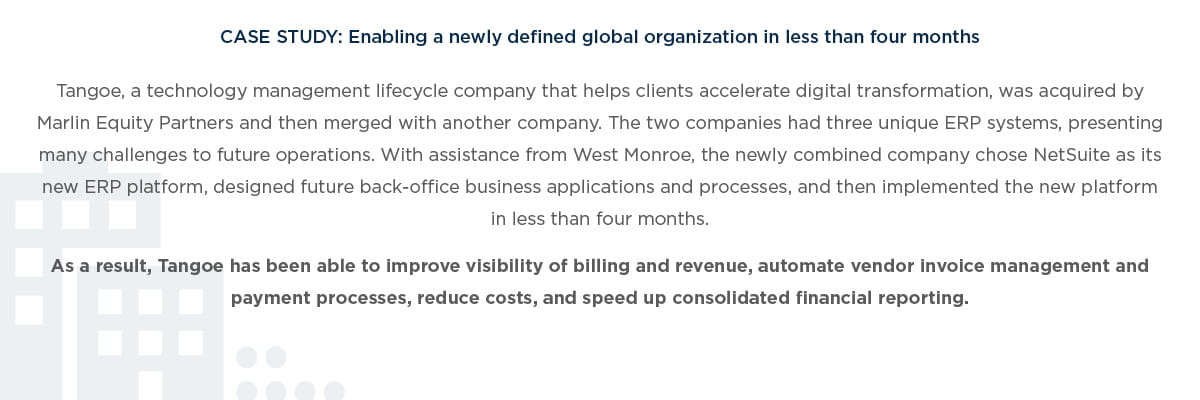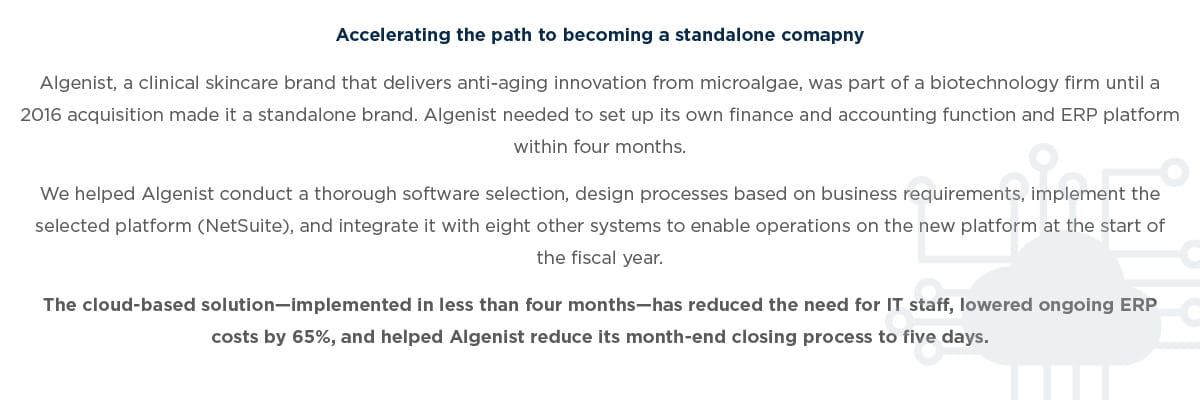
July 2018 | Point of View
"Rapid ERP" done right
Cloud-based ERP solutions offer tremendous potential for building an agile, responsive business primed to compete in today’s digital world.
Introduction
Newer cloud-based solutions are shifting the ERP landscape and accelerating an implementation journey that once took a year or more. While these solutions can speed the time to value significantly, that value could be at risk if rapid implementation skips or gives insufficient attention to certain basics. Gartner estimates that 60% of ERP investments are perceived as failures because they don’t achieve the business case or deliver unclear or unmeasurable results.
This white paper outlines key considerations and steps when approaching a rapid ERP implementation project to make sure it remains on track to deliver expected value.
Chapter 1: A changing ERP landscape targets greater speed to value
The continued shift to the cloud is dramatically changing the enterprise resource planning (ERP) landscape. It has motivated traditional industry leaders to develop their own cloud-based solutions (for example, SAP’s S4 HANA Cloud and Microsoft Dynamics 365) or to acquire solutions in that space (for example, Oracle’s acquisition of NetSuite and Sage’s acquisition of Intacct).
At the same time, vendors are moving to meet demand for accelerated implementation timelines, shifting ERP deployment from year(s)-long endeavors to months or even weeks. For example, Oracle NetSuite’s SuiteSuccess targets 100-day implementation, while SAP and Microsoft offer rapid deployment programs (Lighthouse and Rapid Start, respectively).
Influenced by Agile methodology and concepts, vendors are enabling phased ERP implementation—that is, establishing core functionality first and then building out more advanced features and integrations over time—to help companies achieve business value faster (e.g., process automation, real-time reporting). Similarly, many adopters are choosing to start with out-of-the-box and pre-configured functionality based on the ERP vendor’s knowledge of the software and industry. Once the solution is up and running, developing the business case for additional custom capabilities that address specific business needs.
A fragmented landscape makes software selection more challenging 60% of the market. Today, Gartner profiles more than 20 ERP systems, many of which offer various ERP products based on company size and cloud vs. on-premises needs. It’s important to keep in mind the following when picking the right tool:
Small doesn’t mean easy: ERP complexity isn’t driven by revenue size, rather by how the company has grown and is currently structured. Many organizations have grown through multiple acquisitions, creating complexities in extracting and merging data from a variety of legacy systems, coordinating disjointed processes, and managing a varied group of stakeholders.
Ownership matters: A private equity- owned business will need to consider both its current and potential future ownership. Depending on where the company is in the hold period, timing and appetite for spend can be constrained.
Global operations create complexities: Picking a “global ERP tool” is only the beginning. Local country rules and regulations, processes, and languages need to be considered.
Without the fundamentals, any ERP project – accelerated or otherwise – can fail Successful implementation of any major new solution requires careful attention to people, processes, and technology. Rapid implementation delivers new technology, but it doesn’t leave much margin for addressing changes to people and processes. Even if the technology is flawless, inadequately developed business policies and processes or unprepared users can cause that system to “fail.” Similarly, insufficient attention to data accuracy can lead to problems such as missing data or inaccurate data mappings—which, in turn, will lead to adoption issues (e.g., a user cannot perform their day job in the new system). In short, having less time to manage the change and ensure accurate data during migration increases the risk of successful implementation, potentially affecting the timeline, budget, scope, or quality—or all of the above.
Chapter 2: Accelerated ERP projects cannot bypass ERP implementation fundamentals
While faster implementation shortens the time to value, it is important to understand that the required activities—from kick-off activities that align the organization to data migration—have not changed. They just need to happen faster, in parallel with other activities, or with less intensive effort. The following elements are essential to success:
Break implementation into phases: What’s more important, hitting a target date or having all desired functionality? The answer to that question will help in determining the “must-haves” for day one and the phases of implementation that will follow it.
Kick-off: Accelerated projects cannot circumvent the upfront work necessary to identify and align the team of people involved; the goals and milestones for the project; the go/no go criteria (e.g., cleansing data by a particular time or ensuring ability to work weekends and holidays if needed); and the metrics and criteria for success. Until that happens, a project is not ready to proceed. These assumptions should be detailed and agreed to before any setup or design work begins and evaluated every week of the project.
Design documentation: Accelerated projects typically use an iterative design process using existing software to perform “conference room” pilots rather than a traditional approach of building detailed requirements documentation before designing the solution.
With iterative design/sprints, it is still important to maintain clear requirements documentation to avoid revisiting design decisions. Keeping public meeting notes can help.
Leadership continuity: Many transactions create leadership changes and job openings. Without the right leaders in place, a knowledge gap emerges, which can create needless re-work once new leadership is eventually hired if the right decisions aren’t made.
Testing and training: Accelerated implementation projects often must combine these elements. This may require additional resources to be involved for more personalized help. In addition, having users write their own test scripts and then test can be a short-term replacement for traditional classroom training.
Data migration: Accelerated projects often migrate just opening balance sheets rather than all historical transactional data. The master data strategy may use only newer data—for example, only customers and vendors with activity in the past three to six months— while older data is archived in the legacy system or a new third-party data storage application.
Chapter 3: In accelerated ERP implementations, more emphasis shifts to post-to-live activities
While an accelerated implementation scenario requires many of the same elements as a traditional ERP implementation, the sequence of activities may need to shift—in particular, placing more focus on what comes after the go-live date (e.g., “hypercare” post go-live support from the implementation team).
Plan for an extended go-live period: In an accelerated deployment, “going live” happens over more than a single day—think of it more like a go-live month. Typically, the process will identify data absolutely required for day-one, such as orders that need fulfilling or invoices that must be generated, and then phase the cutover for less critical data. A mock cutover may not be required depending on the complexity of data translation.
One critical factor in determining the ability to phase implementation is integration requirements with other systems. An organization may be able to use manual file uploads to facilitate accelerated implementation, depending on the volume of data and frequency with which the organization needs to update/sync data. Otherwise, a crawl-walk-run approach to integrations may be warranted, including considering alternative solutions with pre-built integrations.
When pursuing phased implementation, it is important to define the phases at the start of implementation.
This helps establish realistic expectations about what functionality to expect and when. Before beginning each new phase of implementation, the project team should take time to ensure that the new system, processes, and roles are still stable; otherwise, it risks overloading essential project resources. Similarly, project teams should conduct “go/no go” assessments of future phases to make sure assumptions and anticipated benefits still hold true and that user requirements have not changed. Finally, during phased implementation, the project team should make sure that implementation costs—both internal and any external consulting costs—remain aligned with expected project benefits.
Provide adequate post-implementation support and training: Given the speed of deployment, a company must be prepared with a way to log, categorize, and prioritize issues that occur once users begin interacting with the system. Holding “office hours” can help with identifying and addressing user concerns. It won’t be possible to resolve every issue immediately; some may need to become enhancements in a future phase of development.
Establishing a formal change review board can help with vetting and prioritizing proposed system changes. It will also be helpful to define escalation criteria and have a template for submitting enhancement requests that gathers the necessary information (e.g., impact, level of change, time to implement, impacted processes and users, alternatives considered, estimated cost) for making decisions.
A support function is just as critical in accelerated scenarios as it is in traditional ERP implementation—but in the case of an accelerated project, it can be tougher to draw the line between implementation activities and support activities. To facilitate a smooth transition, it is important to identify a system administrator—either internal or outsourced—at the beginning of the project.
Expect implementation and support resources to learn side-by-side throughout the process and for the implementation team to provide “hypercare” during the first few months following go-live, before the support team takes over.
Chapter 4: Don’t skimp on change management
Introducing a new ERP solution is a significant change for any organization because the technology is at the core of operations and touches such a wide group of stakeholders. The organization must be prepared to absorb changes in process and behavior as well as technology. Arguably, the need to engage the right system users increases in an accelerated implementation scenario.
These six essential change management principles must be present to ensure progress toward goals:
Vision, desired outcomes, and key performance indicators (KPIs): The organization needs to let system users know the expectations and accountabilities for using the new system.
Leadership engagement: Key decision makers and leaders must be aware of the changes required within the organization, and they must buy in to their responsibility for holding direct reports accountable for using the new system and processes.
Organizational alignment: This involves defining new roles and responsibilities that reflect future technology and processes, ensuring that incentives are motivating the desired behaviors, and establishing appropriate governance and controls. Conducting an impact assessment provides a foundation for designing new roles and then educating employees with respect to changes in roles and expectations for using the new system. To be effective, the assessment should dig down to the level of day-to- day responsibilities.
Communication: Employees not only must be aware of changes, they must feel involved, well-informed, and have time to deliberate the changes before committing to adopt future processes and technology. This proves to be especially challenging in an accelerated scenario with rapid development sprints.
Training and support: This is particularly important in larger organizations where most people will not have a chance to be involved in design. A single classroom training session at the end of implementation is not sufficient. Rather, “day-in-the- life” exercises and process walk-throughs prior to formal training allow people more time to comprehend changes.
Additionally, for a change as critical as an ERP system, it is also important for people to know where they can go for support, whether that is an existing IT help desk or a shorter-term “hypercare” structure.
Change readiness: Lack of readiness can have a debilitating effect on daily operations and impact customers. It is critical, therefore, to gauge change readiness through surveys or other feedback mechanisms.
Conclusion
Understand what changes, and what does not
Cloud-based ERP solutions offer tremendous potential for building an agile, responsive business primed to compete in today’s digital world. But the ability to introduce these new ERP capabilities faster today hasn’t changed some of the fundamentals of effective implementation. Without those fundamentals in place—including careful consideration to preparing employees for changes in their roles and job activities— even the most advanced technology solution will fail to deliver on expectations. Before embarking on a rapid ERP implementation project, even an experienced ERP implementation team is well-advised to take stock of what it can accelerate and what it cannot.



